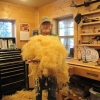We need to convince the viewer that the boat really is drawn up on the beach, and this can only be done through correct perspective. Our boat has no straight lines, only curves, which makes the task a little tricky. This is where your preparation, and especially your model, will really help. More than anything:

| 06 March 2014 11:56
The Dory project really makes me want to try some relief work - how much 3d one can get into a flat piece of wood, and the grain going with the subject SO well. Thanks.
I look forward to part two !

| 03 March 2014 15:23
Paul - I had SOME idea, but it worked out better than I hoped - what a joy! Here's how to think: A tree is a cylinder of concentric rings. If you unrolled it, you'd have strata rather than rings. With me? And you could compare the stacked planes of the rings like the height contour lines on a survey map. As objects move in and out of the wood, they cut the 'contour' lines, ie the ring or grain pattern. So you can visualise what might be the result of moving in and out of the wood...

| 26 February 2014 22:02
This is wonderful work. It is amazing how you compress all that perspective, and the complex curves of the boat as Eric pointed out into such a shallow depth. All too complex for me just yet, but something I aspire to.
Oh, and the word you were looking for when you said 'sternpost' was 'stem', I think. Not so much confusion about which end of the boat was which as a confusion over two consonant terms.
And I love the way the grain of the wood echoes the lines of the strakes. I had assumed you'd planned that all along :)

| 21 February 2014 13:20
What is absolutely fascinating about your relief project with the dory, is that anyone who has made or planked a boat knows how utterly complex the compound curves are for the lines on a boat, including the twist of the planks. And Chris has not only handled all that, but put the whole thing into multiple points of perspective in only an inch of depth. Wow. Mind bending. Your lessons are invaluable.